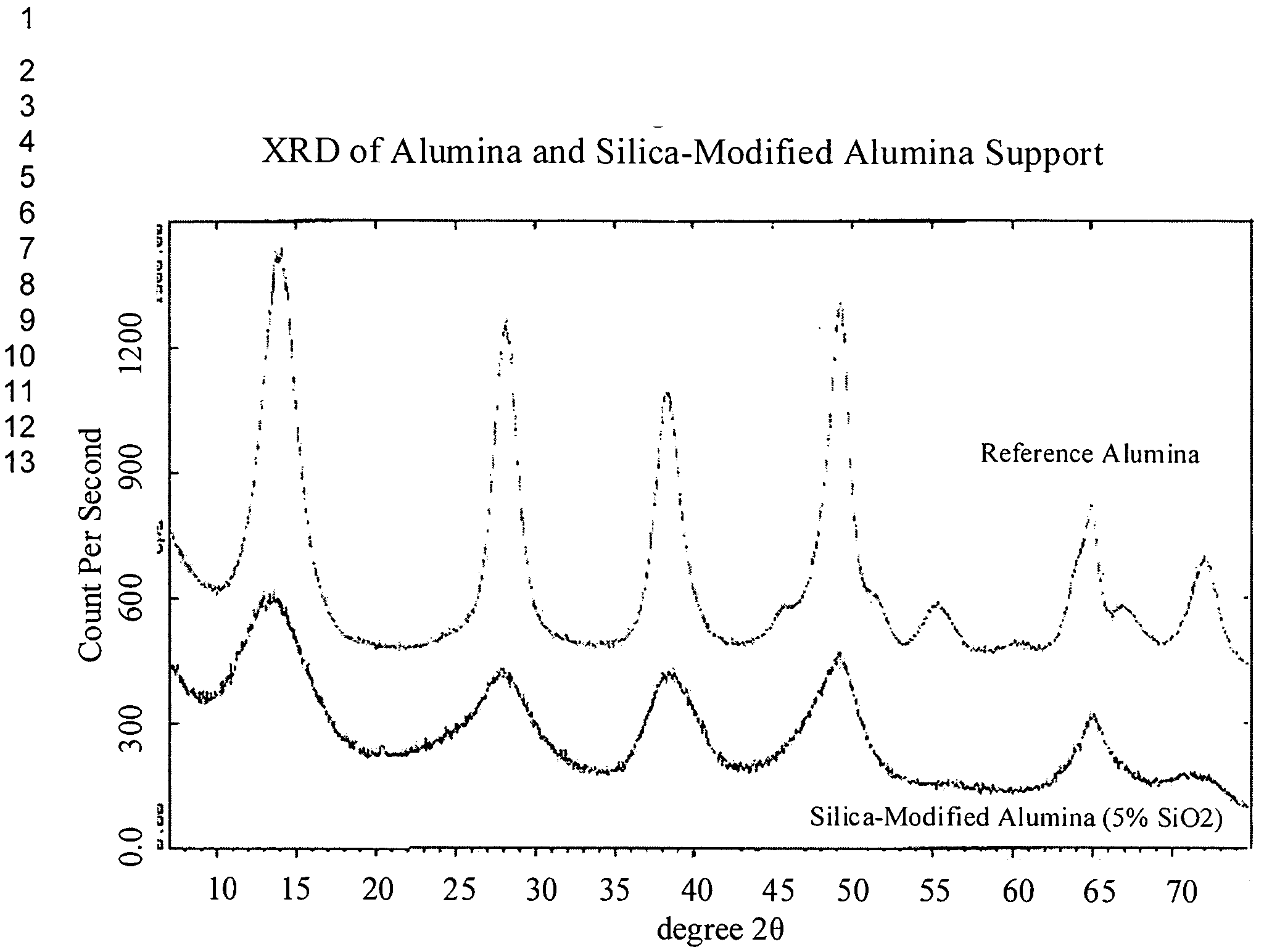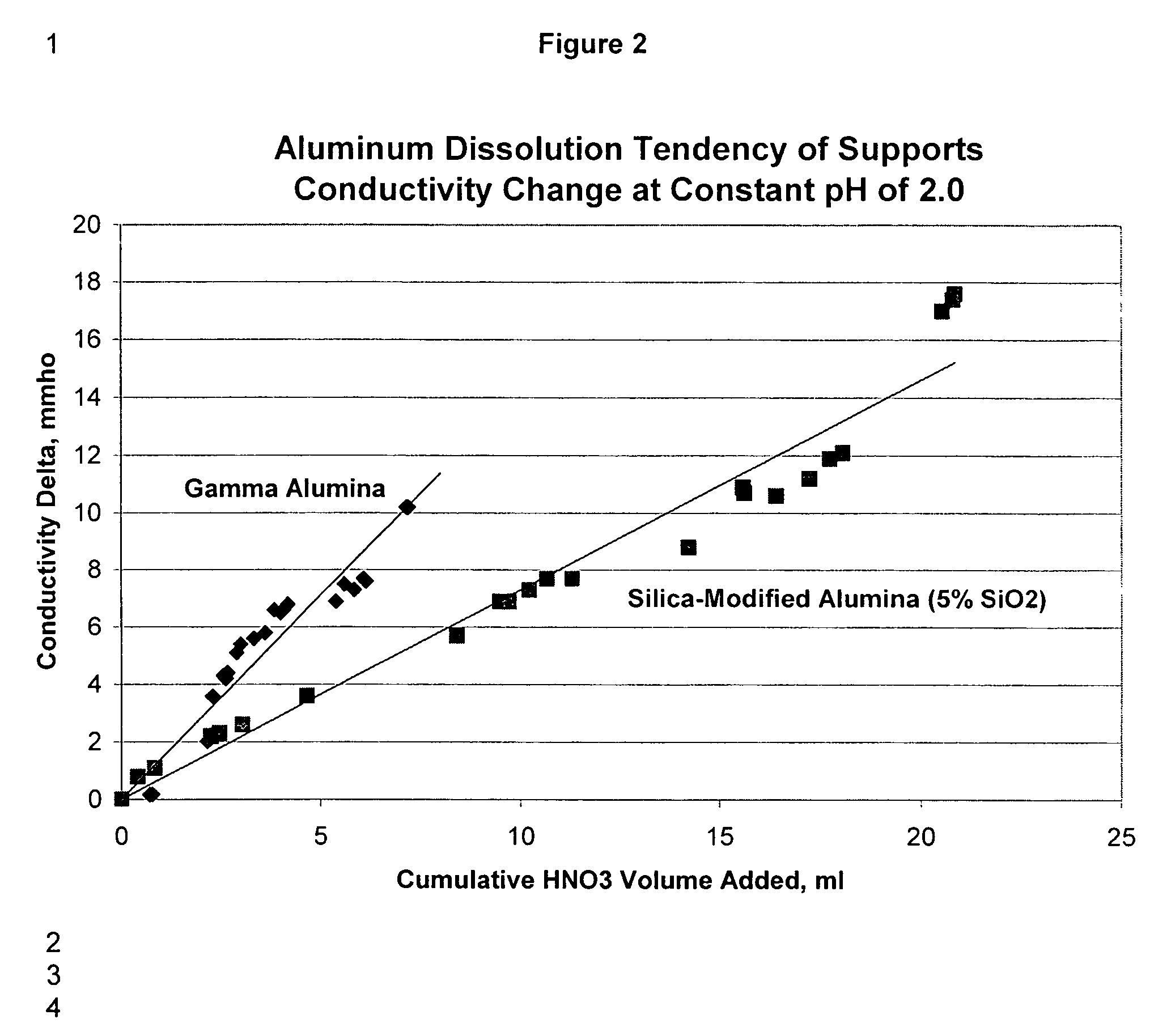Homogeneous modified-alumina Fischer-Tropsch catalyst supports
a technology of alumina and alumina cogel, which is applied in the direction of physical/chemical process catalysts, metal/metal-oxide/metal-hydroxide catalysts, etc., can solve the problems of poor maintenance of catalyst integrity, possible fines generation, and alumina support stability problems, so as to achieve a wide range of line width, reduce intensity, and widen the effect of line width
- Summary
- Abstract
- Description
- Claims
- Application Information
AI Technical Summary
Benefits of technology
Problems solved by technology
Method used
Image
Examples
example 1
Synthesis of Silica-Modified-Alumina (2.5% SiO2 / 97.5% Al2O3)
[0030]An acidic aluminum solution (Solution I containing 10 wt % Al2O3) was prepared by dissolving 2309 g of AlCl36H2O and 13.7 g of hydrochloric acid (37% concentrated) in 2553 g of deionized water. A dilute solution of sodium silicate (Solution II containing 0.30 wt % SiO2) was prepared by diluting 43.6 g of concentrated sodium silicate solution (contains 29 wt % SiO2 and 9% Na2O) with deionized water. The alumina / hydrochloric acid solution (Solution I) and the silicate solution (Solution II) were pumped separately and simultaneously into the mixing chamber of an in-line blender. Mixing in the in-line blender was vigorous with 1600 RPM blender-blade rotation. The volume of the mixing chamber is smaller than the total volume of solutions pumped in 1 minute (i.e., less than 1 minute residence time per volume). The mixing produced a clear silica and alumina solution at the outlet of the inline blender (Solution III). The pH ...
example 2
Synthesis of Silica-Modified Alumina (5% SiO2 / 95% Al2O3)
[0034]The preparation procedure of this silica-modified alumina was similar to Example 1. The concentrations of Solution I and Solution II are modified to produce a combined solution of silica and alumina to a composition of[0035]Si / Al atomic ratio of 0.045[0036]H+ / Na+ molar ratio of 1.1
[0037]Then the product from the in-line blender (Solution III containing the silica and alumina sol) and the dilute ammonia solution (Solution IV containing 8 wt % NH3) were pumped separately and simultaneously into the mixing chamber of a second in-line blender for gel formation. Then the gel product was purified via ammonium exchange and deionized water rinse. Physical properties of the final silica-modified alumina are summarized in Table 1.
example 3
Synthesis of Silica-Modified Alumina (10% SiO2 / 90% Al2O3)
[0038]The preparation procedure of this-silica-modified alumina was similar to Example 1. The concentrations of Solution I and Solution II are modified to produce a combined solution of silica and alumina to a composition of[0039]Si / Al atomic ratio of 0.094[0040]H+ / Na+ molar ratio of 1.1
[0041]Then the product from the in-line blender (Solution III containing the silica and alumina sol) and the dilute ammonia solution (Solution IV containing 8 wt % NH3) were pumped separately and simultaneously into the mixing chamber of a second in-line blender for gel formation. Then the gel product was purified via ammonium exchange and deionized water rinse. Physical properties of the final silica-modified alumina are summarized in Table 1.
PUM
| Property | Measurement | Unit |
|---|---|---|
| 2θ | aaaaa | aaaaa |
| temperature | aaaaa | aaaaa |
| width | aaaaa | aaaaa |
Abstract
Description
Claims
Application Information
 Login to View More
Login to View More - R&D
- Intellectual Property
- Life Sciences
- Materials
- Tech Scout
- Unparalleled Data Quality
- Higher Quality Content
- 60% Fewer Hallucinations
Browse by: Latest US Patents, China's latest patents, Technical Efficacy Thesaurus, Application Domain, Technology Topic, Popular Technical Reports.
© 2025 PatSnap. All rights reserved.Legal|Privacy policy|Modern Slavery Act Transparency Statement|Sitemap|About US| Contact US: help@patsnap.com



